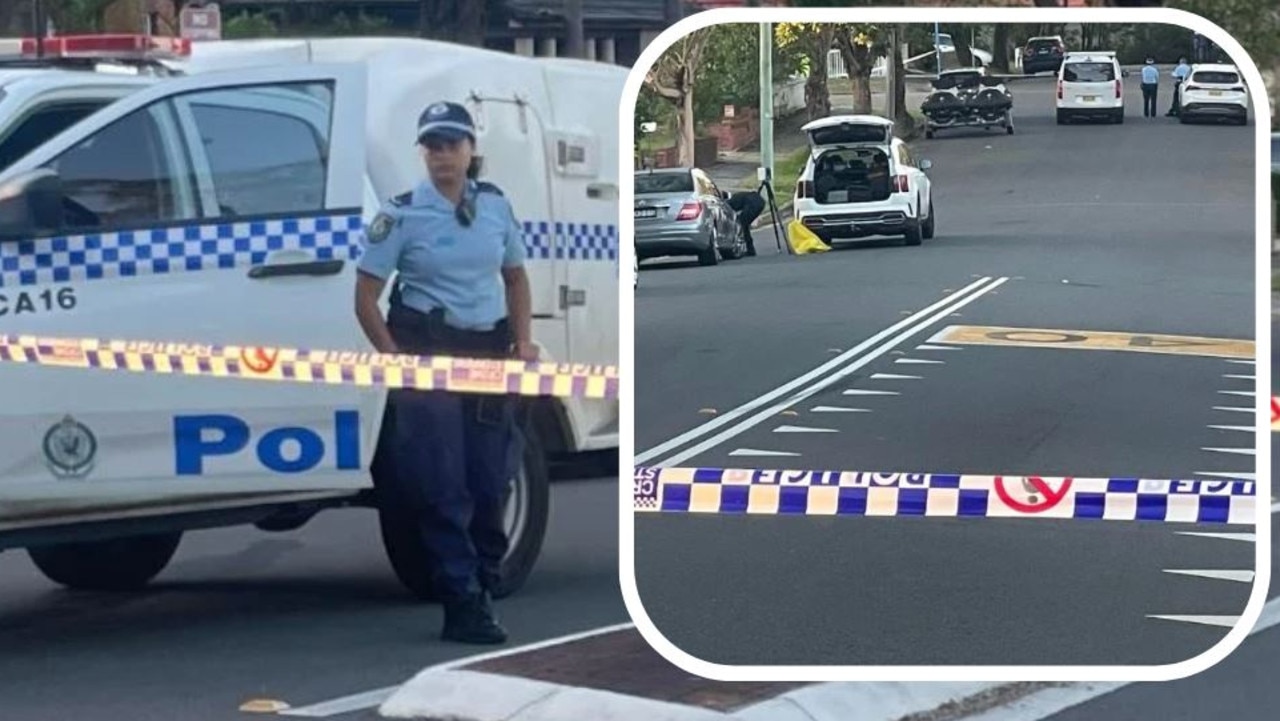Anthony Albanese reveals $368bn AUKUS nuclear subs deal to become major naval power
Anthony Albanese has declared a historic AUKUS nuclear subs deal “an Australian sovereign capability”, while Joe Biden said the US could ask for “no better partners”.

News
Don't miss out on the headlines from News. Followed categories will be added to My News.
Australia will spend up to $368bn to deliver a historic nuclear submarine program featuring at least three boats bought from the US, upgrades to extend the life of our existing fleet and eight homemade nuclear subs hitting the water from the 2040s.
Prime Minister Anthony Albanese unveiled the long-awaited AUKUS plan at a US naval base in San Diego on Tuesday morning Australian time alongside US President Joe Biden and UK Prime Minister Rishi Sunak, in what the leaders say is a crucial move to keep the peace in the Indo-Pacific amid increasing Chinese aggression.
More than 20,000 jobs will be created over the next three decades, with the entire scheme to cost between $268bn and $368bn – the equivalent of 0.15 per cent of Australia’s gross domestic product averaged over the life of the program.

The AUKUS partners have agreed after an 18-month planning process to a four-phase plan which will:
INCREASE the regularity of US nuclear-powered submarines visiting Australia from this year, with more UK boats to visit from 2026.
ENABLE forward rotations of up to four US nuclear submarines and one UK boat through HMAS Stirling near Perth from 2027.
DELIVER three US Virginia-class nuclear submarines to Australia in the 2030s, with the potential for up to two more to be handed over to prevent a capability gap as the existing Collins-class fleet is retired. These boats – which could be new or second-hand – will also be based out of Western Australia.
CREATE a new SSN-AUKUS fleet based on a UK design with cutting edge technology – including common combat and weapons systems – from all three countries.
The UK will start building its first boat this decade and deliver it in the late 2030s, before the first SSN-AUKUS built in South Australia goes into service in the early 2040s.
Speaking in front of the USS Missouri, a Virginia-class nuclear submarine, Mr Albanese said it was the beginning of “a new chapter in the relationship between our nation, the United States and Great Britain”.
“This is a genuine trilateral undertaking — all three nations stand ready to contribute and all three nations stand to benefit,” he said.
He hailed the SSN-AUKUS as “an Australian sovereign capability — built by Australians, commanded by the Royal Australian Navy and sustained by Australians in Australian shipyards”.
“Our agreement unlocks a set of transformative opportunities for jobs and skills and research and innovation,” Mr Albanese said alongside Mr Biden and Mr Sunak.
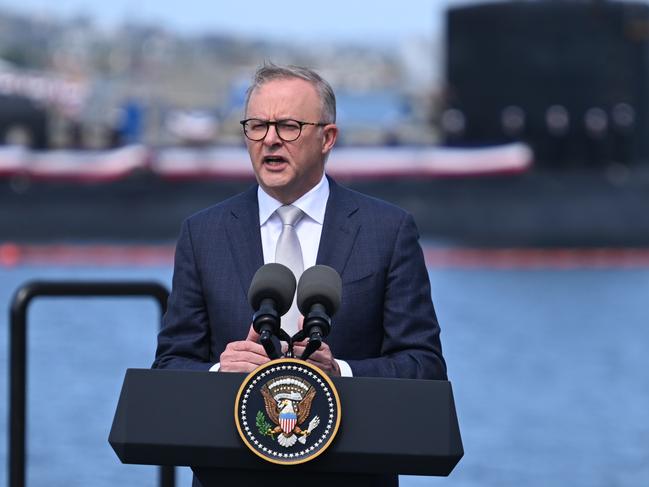
“Opportunities that will shape and strengthen and grow Australia’s economy for decades and create around 20,000 direct jobs for Australians from many trades and specialisations.”
“Our future security will be built and maintained not just by the courage and professionalism of our defence forces, but by the hard work and know-how of our scientists and engineers, our technicians and programmers, electricians and welders.”
The prime minister compared the forthcoming industrial effort to the creation of Australia’s automotive sector in the post-war period.
“Just as the vision of of Curtin and Chifley in creating our automotive industry lifted our entire manufacturing sector, this investment will be a catalyst for innovation and research breakthroughs that will reverberate throughout the Australian economy and across every state and territory,” he said.
“I look out from here today and I see new frontiers in innovation to cross. New breakthroughs in technology to achieve. A new course for us to chart together.”
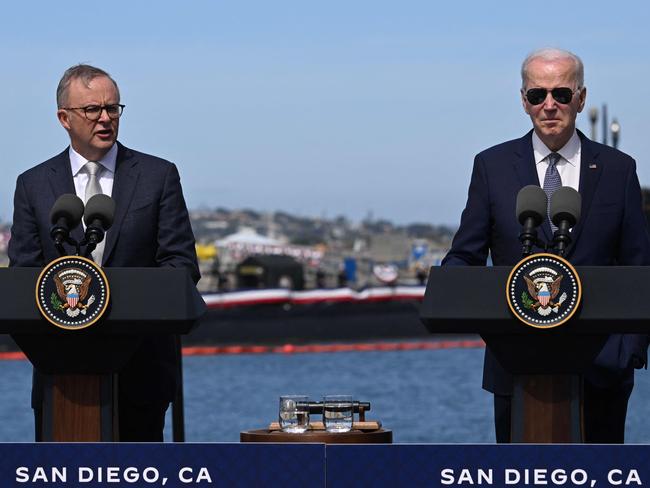
While he did not specifically call out China’s mounting aggression, Mr Albanese said the AUKUS partners were acting in line with their common values, and that they had an “unwavering conviction that whatever the challenges ahead, the cause of peace and freedom will prevail”.
“We are bound above all by our belief in a world where the sovereignty of every nation is respected, and the inherent dignity of every individual is upheld,” he said.
“Where peace, stability and security ensure greater prosperity and a greater measure of fairness for all. And where all countries are able to act in their sovereign interests free from coercion.”
Mr Biden said AUKUS had “an unusual name” but was a critical step for all three countries, and that the US could ask for “no better partners” in the Indo-Pacific than Australia and the UK.
Under the plan, the President said he was determined to help Australia develop its nuclear submarine capability as quickly as possible, including by selling at least three Virginia-class boats to Australia in the 2030s.

“The ultimate goal isn’t just selling subs to Australia — it’s developing something new together,” he said.
Mr Biden repeatedly emphasised that Australia’s submarines would not be armed with nuclear weapons and that Australia would not produce nuclear fuel for the boats, as he described America’s nuclear stewardship as a point of pride.
Mr Sunak unveiled a massive spending boost for the UK’s defence force to remain “one of the world’s leading defence powers”.
But he said this had to happen in partnership with the AUKUS allies, as he described the new nuclear submarine as one of the most advanced capabilities the world had ever known.
At the end of the event, Mr Biden looked to his fellow leaders and declared: “You’re the best, and we’re going to be the best in the world.”

Earlier, Mr Albanese and Defence Minister Richard Marles said it was “the single biggest investment in our defence capability in our history and represents a transformational moment for our nation, our Defence Force and our economy”.
“Together with our AUKUS partners, the Albanese government will deliver the optimal pathway, providing a superior and sovereign capability, generations of jobs and a record level of investment which will keep Australians safe,” they said in a statement.
In a trilateral meeting prior to the announcement, asked by reporters whether the US could be relied upon to deliver the AUKUS plan, Mr Biden said: “We can always be relied upon.”

Australia will also spend up to $6.4bn to extend the life of its six conventional Collins-class boats into the 2040s, meaning the Navy may be operating three separate submarine models by then.
The life-of-type extensions will begin in 2026, supporting 1500 jobs at South Australia’s Osborne shipyard.
Overall, the government will invest $9bn in the May federal budget over the next four years, including $2bn in South Australia and $1bn in Western Australia.
Breaking: Australia will spend up to $368bn to deliver an historic nuclear submarine program featuring at least three boats bought from the US, upgrades to extend the life of our existing fleet and eight homemade subs hitting the water from the 2040s. https://t.co/2fohqQUDUSpic.twitter.com/BfA49rm4me
— Tom Minear (@tminear) March 13, 2023
Mr Albanese, Mr Biden and Mr Sunak said in a joint statement that the plan “elevates all three nations’ industrial capacity to produce and sustain interoperable nuclear-powered submarines for decades to come, expands our individual and collective undersea presence in the Indo-Pacific, and contributes to global security and stability”.
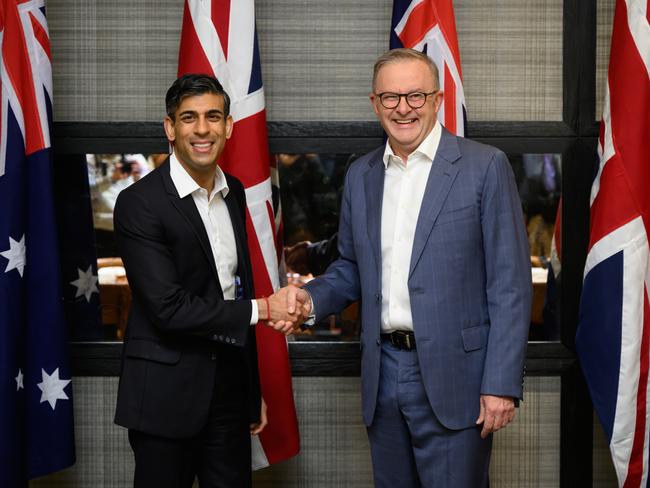
Hundreds of Australian civilian and military personnel will begin to work at US and UK shipyards from this year so they are trained to lead the industrial transformation down under.
Australia will also make a “proportional investment” in American and British shipyards of about $3bn over the next four years, while the US invests an extra $US2.4bn ($A3.6bn) by 2027 to boost its submarine construction capacity so it can maintain its own fleet before delivering Virginia-class boats to Australia next decade.
While the three leaders acknowledged the need for “robust, novel information sharing and technology co-operation”, the White House did not detail how it would cut through export controls that experts have warned could hamper the AUKUS plan.
In South Australia, the construction of a new nuclear submarine shipyard will start this year, supporting up to 4000 jobs at the peak.
A further 4000 to 5000 jobs will be supported at the peak of the submarine construction program in 20 to 30 years – almost double what was forecast for the cancelled French Attack-class submarine scheme.
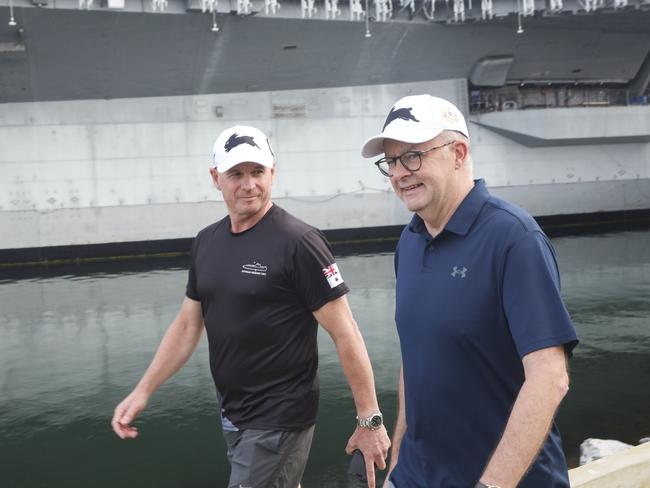
“The AUKUS submarines will be the most complex machines that have ever been built in human history. And they will be built here in South Australia,” South Australian Premier Peter Malinauskas said.
Construction will begin in South Australia this decade on the first SSN-AUKUS boat, which is due to be ready in the early 2040s. One is expected to be produced every two years after that, taking the life of the program out to the 2050s.
Over the next decade, up to $8bn will also be invested in a massive upgrade of WA’s HMAS Stirling base, creating 3000 jobs. This will cater for the forward rotation of US and UK nuclear submarines and provide opportunities for Australian workers to pitch in on maintenance work.
A separate nuclear submarine base will also be built on Australia’s east coast but the Albanese government is yet to confirm its location.
A new workforce strategy to deliver on the AUKUS plan will include a dedicated skills and training academy in South Australia, a nationwide training plan with universities and vocational education providers, and new nuclear science and engineering courses.
The AUKUS leaders maintained the submarine plan would comply with all nuclear non-proliferation requirements, with reactors provided to Australia in welded units that will not require refuelling.
Defence land is likely to be used to dispose of nuclear waste in a new purpose-built facility.
More Coverage
Originally published as Anthony Albanese reveals $368bn AUKUS nuclear subs deal to become major naval power
Read related topics:AUKUS



